
17 April 15. Having set the alarm for some time in the middle of the night we uncurl ourselves from deep sleep, and moan and groan our way out of bed well before sunrise. We quickly wash, dress, and make tea. Hot sweet tea first thing in the morning seems to ignite me for the day; without it I can never quite get going. We head out from our campground cabin near the small town of Jabiru in Kakadu National Park in Australia’s Northern Territory, and drive for about forty-five minutes to Cooinda Lodge. Cooinda is the meeting-point to join the sunrise cruise of Yellow Water.
A “high-rise” all-terrain vehicle takes us from the lodge to the water where we board an open-sided boat. I am spellbound by the beauty of the landscape.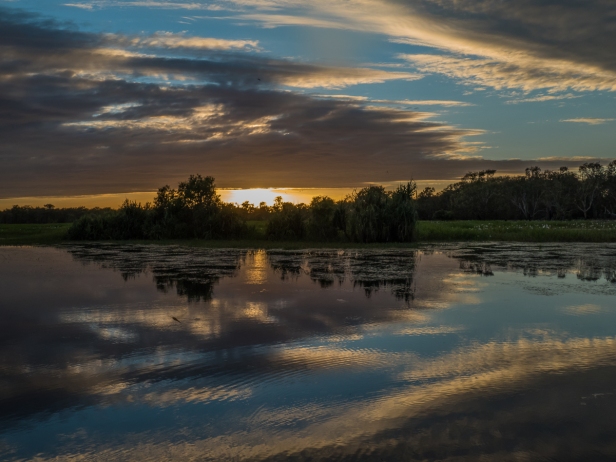
Yellow Water is a land-locked billabong. Billabong, of the “jolly swagman” fame (so jolly he committed suicide rather than be caught for sheep stealing), is an Australian aboriginal word for a branch of a river that is a backwater or stagnant pool. Yellow Water, a backwater of the South Alligator River, is no pool. At the end of the wet season it is huge, and teeming with wildlife. Situated near the centre of Kakadu, it is home to plentiful fish and crocodiles, and its shores are home to wild buffalo and brumbies. Brumbies are wild feral horses. Perhaps the name came from the horses abandoned in 1804 by Sergeant James Brumby when he left New South Wales for Tasmania, or perhaps the name came from the Pitjara Aboriginal word baroomby, meaning wild. Either way it is uniquely Australian.
Yellow Water is also teeming with birds. And it’s not long before we start seeing them in the early morning light. We see comb-crested jacanas with their bright red hats, strutting across the lilypads,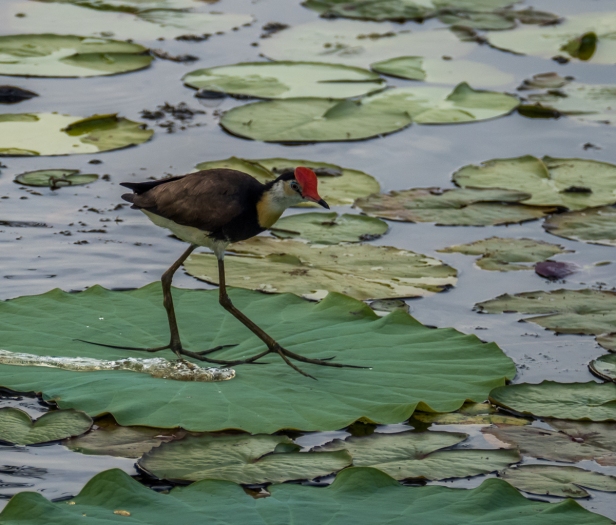
and their chicks. Look at the size of their feet! Large enough to walk on water.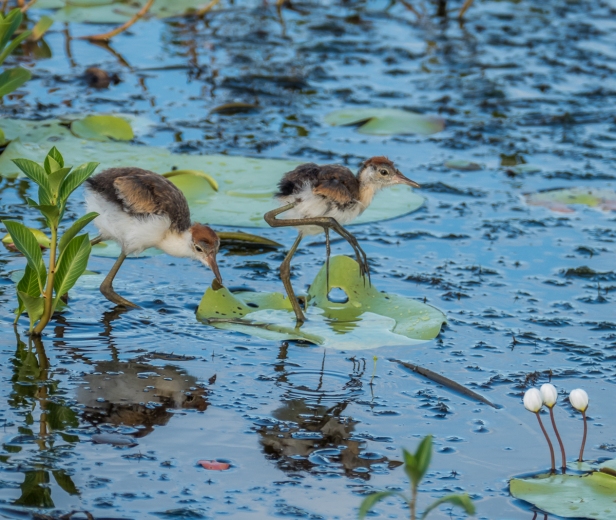
We see several rainbow bee-eaters, all green and golden and a flash of aqua shining in the morning sun.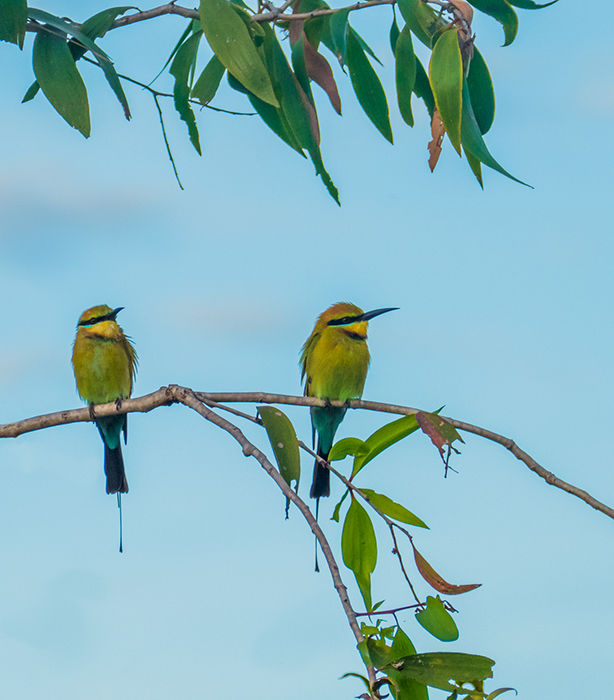
We see a white-breasted eagle, and later, a sea eagle, formidable and majestic birds, rulers of the sky.

We see a whole huge waddle of plumed whistling ducks,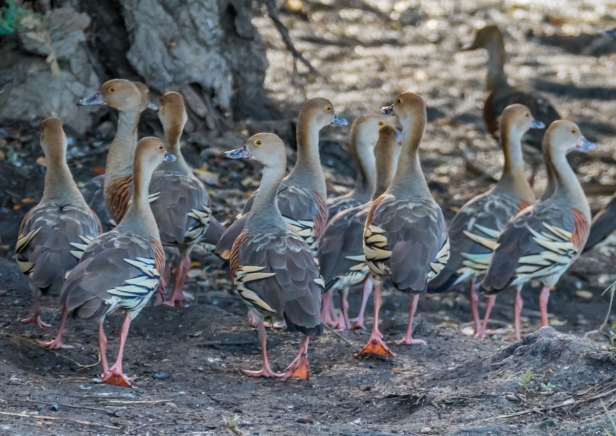
and of course we see prehistoric crocodiles, lurking quietly on the shore almost completely camouflaged in the mud,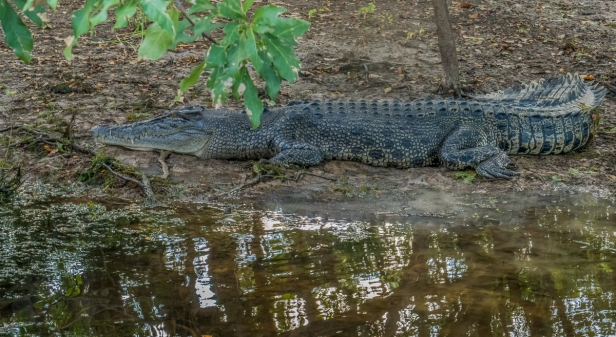
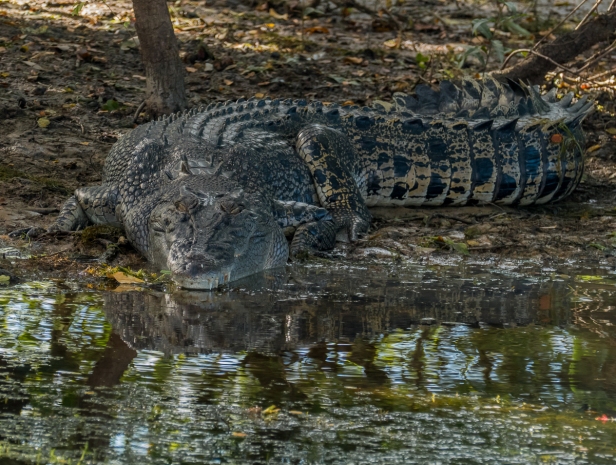
or gliding silently through the water.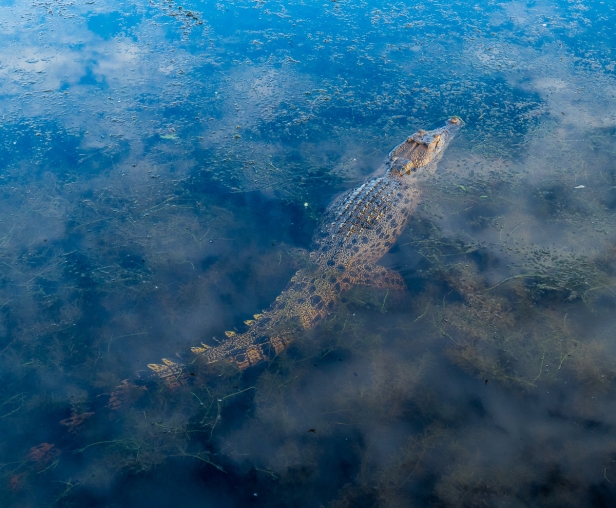
We see jabirus, magpie geese, a rufus night heron, a crimson finch, a darter, a great egret, a cormorant, terns, a whistling kite, a forest kingfisher, and one lone buffalo hiding under a tree.
Nearly two hours after sunrise the boat turns around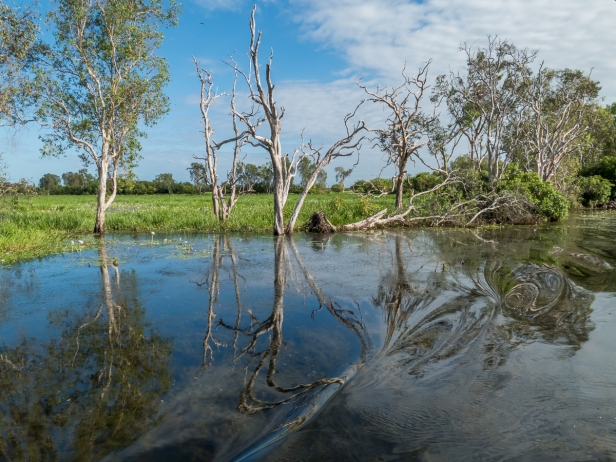
and we head back to Cooinda. Disembarking from the boat we are told to stand in a caged area for our safety until the bus arrives. There is a sign nearby at the water’s edge: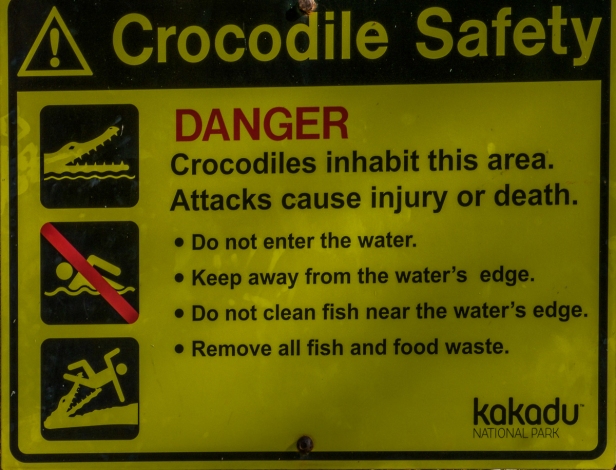
The water doesn’t end at the edge of the billabong. It floods over the road and crocodiles are not interested in such arbitrary distinctions, hence the cage we are standing in. The buses are raised up on huge tires for a reason. This is the road, seen from the front of the bus while driving back to the lodge: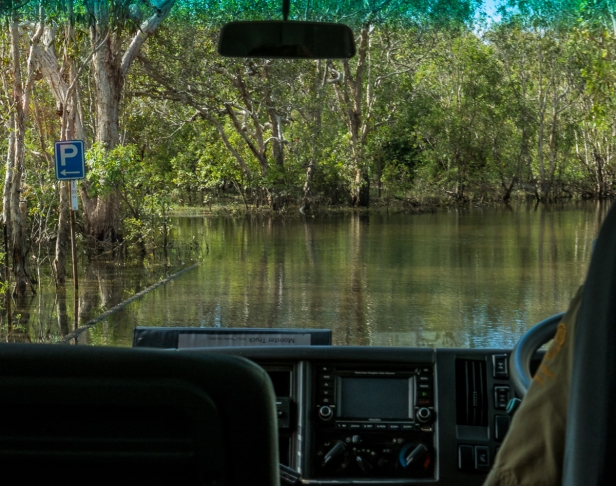
Our time at Yellow Water is wonderful: the early morning light, the birds, the clear water, the almost hidden buffalo, the stealthy crocodiles, the silence. It’s magical. Then we discover Fogg Dam!
27 April 15. Fogg Dam Conservation Reserve is a little less than half way between Darwin and the western boundary of Kakadu National Park. The dam was created in 1956 to collect water for the failed Humpty Doo Rice Project. The failure was largely due to either too much, or not enough water. Although the Aboriginal people, who are closely attuned to the land, identify six separate seasons in the northern part of the country, the simpler separation is between two seasons – the wet and the dry. Growing rice requires something a little more consistent, but the creation of the dam has given access to the vast wetlands without in any way harming it. Bird life is abundant, and it has one of the largest populations of snakes in Australia, although we didn’t see any. Not at Fogg Dam anyway.
We are alone, driving along the narrow, single-lane road surrounded on either side by water crowded with lily pads, lotus, and grasses.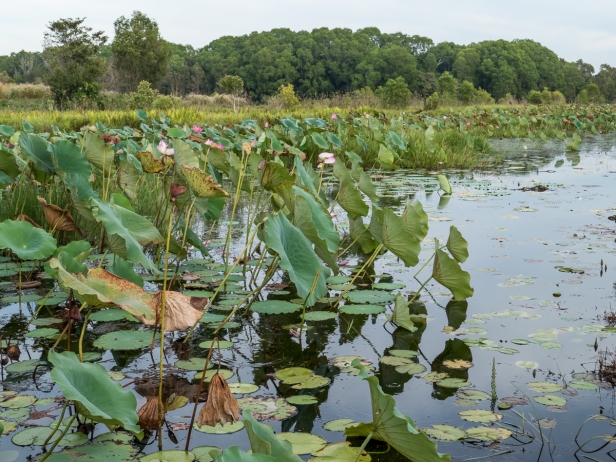
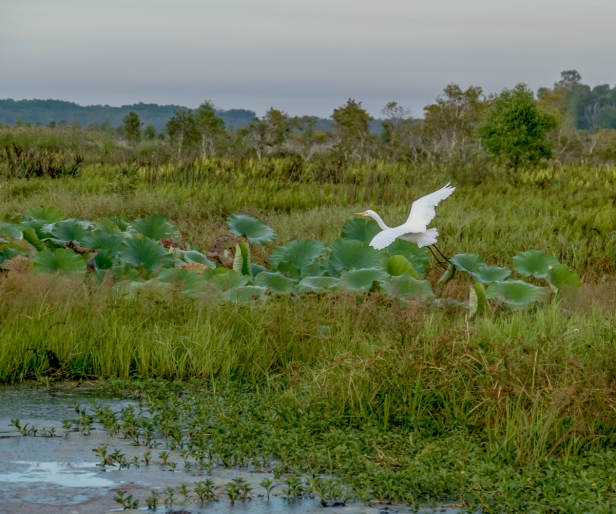

The road is actually the dam wall though it is hardly higher than the water that surrounds it. We drive slowly, watching on all sides. Suddenly I see it. An adult female jabiru in the water right next to the road! We can hardly believe our luck. We stop the car and manage to get out without disturbing it. It feels like we have hours to watch it although it is probably only minutes.
Jabirus are actually storks found in the Americas. The birds found in Australia and Southeast Asia, although commonly known in Australia as Jabirus, are more correctly called black-necked storks. They grow to be about five feet tall with a wingspan of nearly eight feet. The females can be distinguished by their yellow-rimmed eyes.
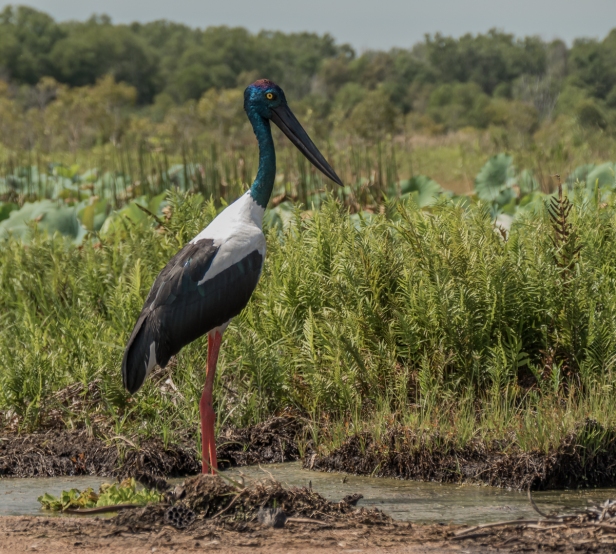
Eventually it becomes aware of us, and flies away. As I watch it lift off on huge powerful wings at close range my eyes follow it into the sky. It is a special moment; to hear the sound of it’s wings, to feel the power, to see the controlled, regal grace as it rises higher and higher.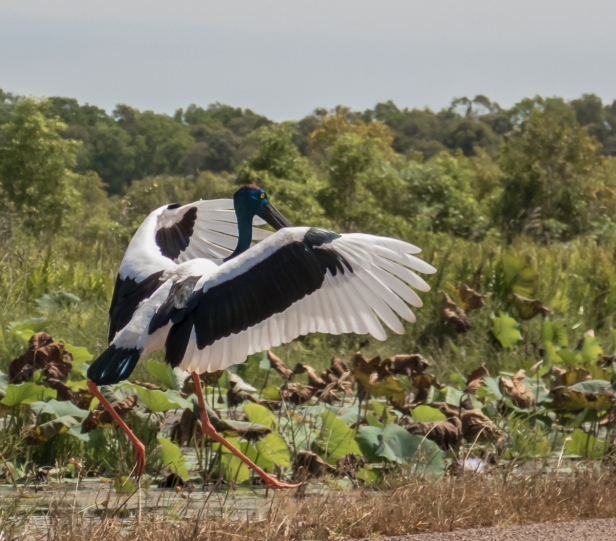
Looking around I immediately see a male jabiru in the water on the other side of the dam wall.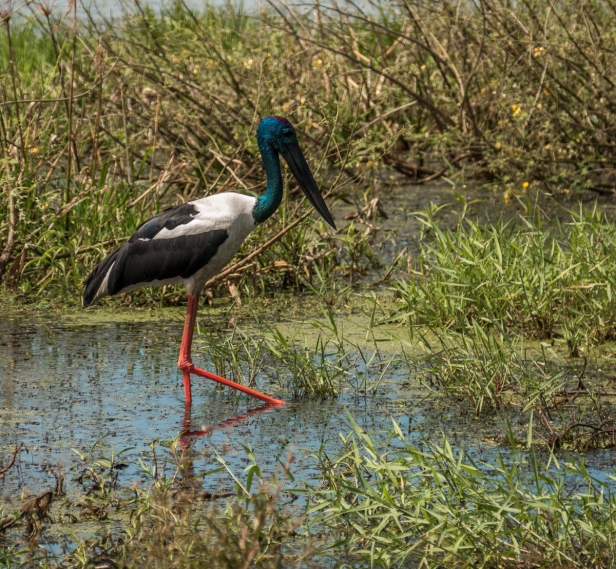
We watch it for a while then it too flies away across the vast wetlands, the flood plains of the Adelaide and Mary Rivers.
There are a great variety of birds all around us, and the further we go the more we see. Eventually we get to the end of the road and park the car. There are boardwalks for longer walks through the wetlands but we are cautious and choose not to walk along them. It is the end of the wet season and the land is flooded with water, which means it is also probably full of crocodiles. Not wanting to be croc dinner we content ourselves with what we can see from either side of the road and the small paved area at the end. What we see is plenty, including a baby crocodile about fourteen inches long. Not big enough to make a meal out of us, but it is enough to indicate the presence of crocs in the area. I should have photographed it next to Don’s foot for size comparison, but Don wasn’t putting his feet anywhere near it.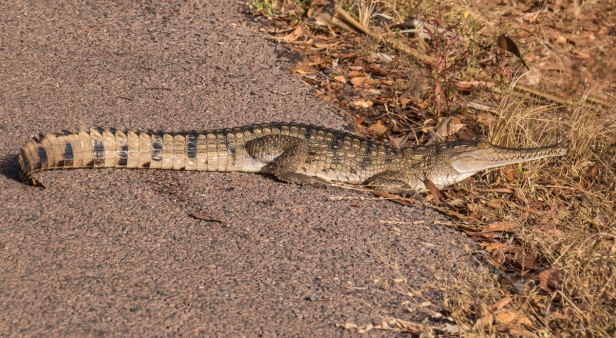
We are excited by the discovery of Fogg Dam. By this time we’ve already spent ten days exploring three of the great national parks of the “Top End”, and Fogg Dam is an afterthought. We have a little extra time so decide to go there on the way to a cruise on the Adelaide River.
We are both astonished and thrilled by the abundance of birdlife to be seen at close range – a smorgasbord of natural beauty spread out before us. And we are all alone in this magical land.
The comical masked lapwing, on the ground and in flight:

And quick, look! Over there in the grass! A brolga!
Elegant Royal Spoonbills with their yellow eyebrows, and their feathery fascinators perched at the back of their heads:
A very busy conference of pied herons,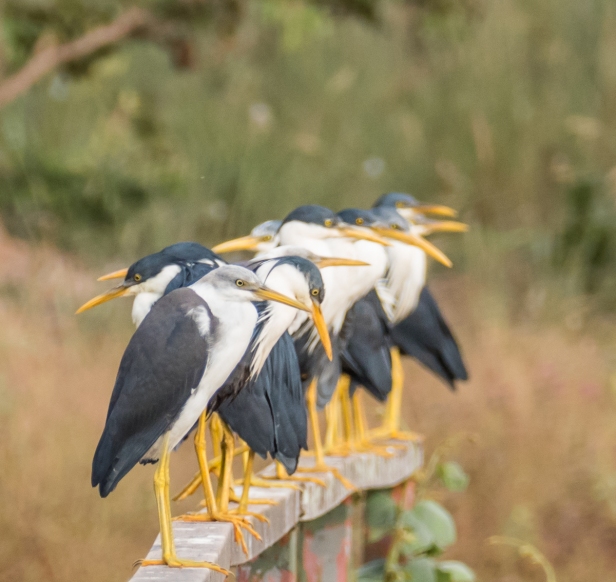
and the last one to leave.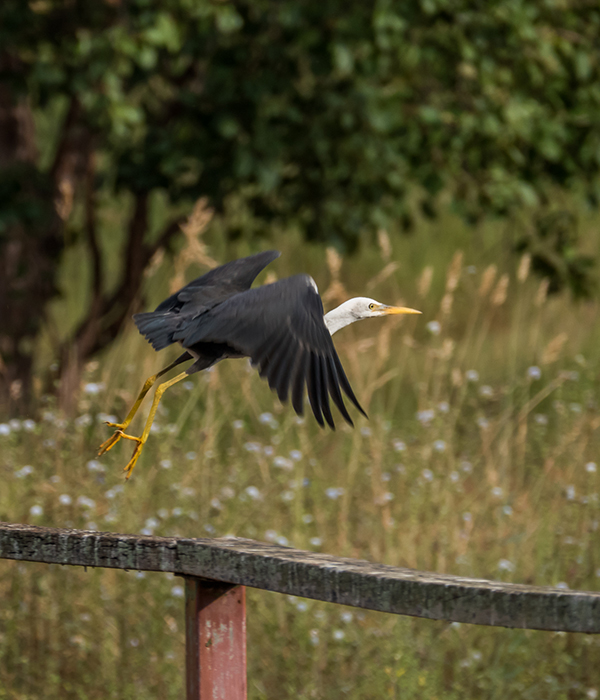
Squabbling great egrets,
and one with a snack.
A whistling kite surveying his world,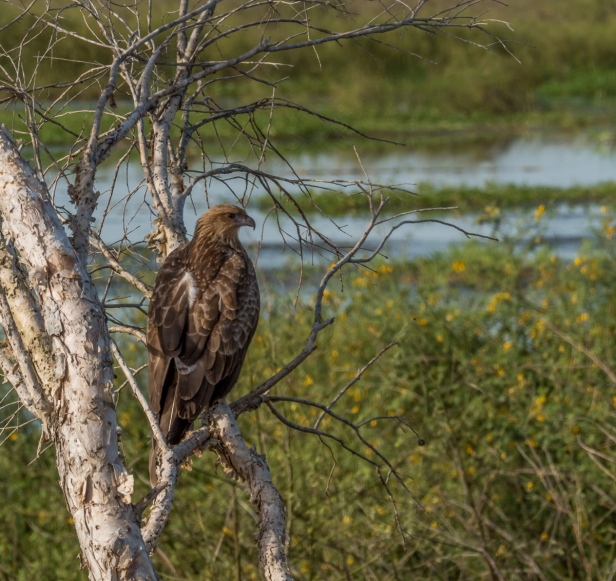
and an Australasian darter.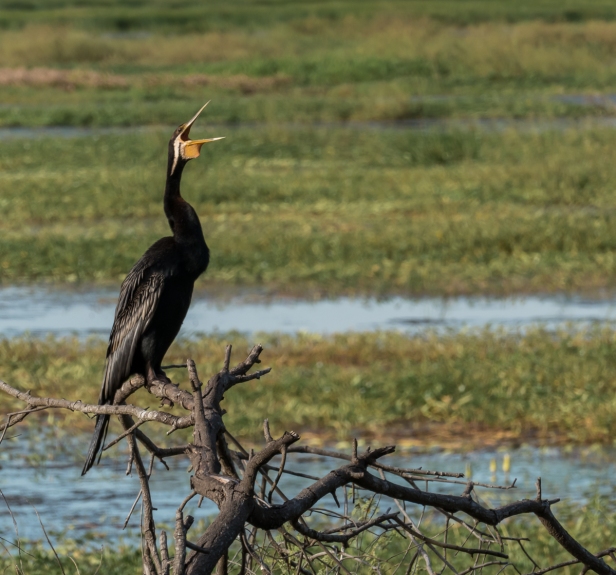
For nature-lovers like us Fogg Dam is a fantastic unexpected feast. Nature’s variety astonishes me. All these birds. All so different. What a gift to have discovered this little-visited area. And to have it all to ourselves.
Still to come: Aboriginal dreamtime art twenty-thousand years old, anthills as high as a house, isolated plunge pools, road trains, trees full of bats, pythons, hot-water rivers, kangaroos, and even more exotic birds.
All words and images by Alison Louise Armstrong unless otherwise noted
© Alison Louise Armstrong and Adventures in Wonderland – a pilgrimage of the heart, 2010-2015.

What a collection of exotic birds, some of which I have never heard of.
LikeLiked by 1 person
Many of them we’d never heard of either. We were really amazed by it all.
Alison
LikeLike
Just what I was thinking! Beautiful colours captured in the photos too!
LikeLiked by 1 person
Thanks so much Adam. Australia’s Top End was an amazing experience.
Alison
LikeLike
What a stunning collection of images from your adventures…I can only imagine how much fun it must be to be there for real – thanks for sharing them, I can feel my wanderlust starting to stir. Peace, Harlon
LikeLiked by 1 person
Thanks Harlon. It was so much fun! We were so excited. Everywhere we looked there was more to see, and the guide on the Yellow Water cruise was an expert at spotting the birds.
Alison
LikeLiked by 1 person
Absolutely fabulous photos and story, Alison. During the period 1984-87 when we lived in Darwin, we used to take our Visitors for a picnic breakfast down to Fogg Dam. They’d grizzle about the early start but be blown away at the bird life. It was all very under developed for tourists in those days and I well remember the giant mosquitos. But all like nothing else we’d seen. Totally unique. You’ve brought it all to life with your stunning photos. As always, thanks again.
LikeLiked by 1 person
Thanks so much Ros. Fogg Dam early morning is amazing. I can imagine all your guests were glad you dragged them out of bed so early once they got there. It certainly is totally unique. When we were there there were no mosquitoes!
Alison
LikeLike
Wow! Breathtaking. You captured the birds beautifully–and their scaly neighbors are mesmerizing. This is now on my map of places to see.
LikeLiked by 1 person
Thank you so much. The Northern Territory is a very special place. We also went to Nitmiluk (Katherine Gorge) and Litchfield National Park which I’ll cover in future posts. It should definitely be on your list!
Alison
LikeLike
Fantastic! The birds remind me of many I saw in Africa, but with their own special Australian frippery.
LikeLiked by 1 person
Thanks Jane. Australian frippery – I love that 🙂
the Top End is really special. Definitely worth seeing.
Alison
LikeLike
While all of these photos made my mouth gape open in awe, the comb-crested jacana on the lilypads simply took my breath away! Even I would get up at the crack of dawn for those birds and views! Stunning.
LikeLiked by 1 person
Thank you so much. We loved the jacanas too. Especially the chicks. Their feet! Both places definitely are worth getting up early for. We were mesmerised and excited at the same time!
Alison
LikeLiked by 1 person
such a rich and beautiful diversity of birds in this ecosystem! thank you for telling such a great story in this post!
LikeLiked by 1 person
Thank you, and you’re welcome! We were completely amazed by the variety and number of birds. Such abundance and beauty.
Alison
LikeLiked by 1 person
gratitude for the tea
that ignited such adventure
and sharing it’s beauty
with me and the world 🙂
LikeLiked by 2 people
gratitude
to be able to have such adventures
to be able to share this beauty
to be in a world with such riches
Alison xox
LikeLiked by 2 people
Those dawn photos are simply stunning Alison and what clear and beautiful photos of the magnificent variety of birds. Any one looking at this post must surely want to visit the magic of the Top End.
LikeLiked by 1 person
Thanks so much pommepal. We were completely entranced, by the birds, and by the beauty all around us. Everyone should visit the Top End!
Alison
LikeLike
I’m lucky enough to have been twice but I would love to visit in their wet season.
LikeLiked by 1 person
I’m with Don on not using his foot to provide perspective on the size of a croc, even a little one. 🙂 Beautiful photos Alison. The Lapwing was indeed humorous. My browser isn’t opening all of the photos. Probably the disadvantage of having satellite. –Curt
LikeLiked by 1 person
Thanks Curt. Aren’t those lapwings weird?! Truly unusual. Too bad you can’t see all the photos. I know from past experience satellite internet can be slow.
Alison
LikeLike
I confess I am just glad I can live out in the woods and get any Internet at all. 🙂
LikeLiked by 1 person
all beautiful…amazing birds…i love the swirl on the water photo…and the feeling of being there 😀
LikeLiked by 1 person
Thanks Hedy. We were so excited to see all these amazing birds. So glad you got the feeling of being there. It’s a really special place.
Alison
LikeLiked by 1 person
Yes I’m getting ready to sell everything and leave as I follow you both ☺️😀📷😎
LikeLiked by 1 person
Lol
LikeLiked by 1 person
my family responded the same ^_^
LikeLiked by 1 person
Such phenomenal photography. Patience and a bunch of skill, I imagine.
LikeLiked by 1 person
Thanks so much Marsha. Some minimal skill, sometimes patience, and sometimes dumb luck 🙂 Oh and extraordinary scenery and birds to photograph! That helps 🙂
Alison
LikeLiked by 1 person
Just another set of lovely photographs. I think I like the one with the line-up pied herons most…strictly artistically speaking. That brolga is one coyote-ugly bird. Your lily looks a lot like the lily in my latest post…I guess lilies look the same everywhere? They’re nice in a pond, but it is rather cool to see them growing wild along the river. Crocodiles are scary, that second shot of croc is real scary. Makes me want to return to Oz.
LikeLiked by 1 person
Thanks BF. I was pleased with the line of herons. I have a bunch of photos of that line-up, from different angles. It was amazing to be able to just stand there and watch them all coming and going. There were so many of them and they were so busy. Brolgas ugly? I think they’re stunning! They’re elegant cranes! 🙂 Yeah crocs are scary – we sure were warned a lot about them. I have some great croc stories to come. When you next have time off go to the Top End instead of Bali 🙂
Alison
LikeLiked by 1 person
Brolgas…yeah, it’s just that red stuff on their faces that gets me! Can’t wait for the croc stories. I have spent time the top end a couple times, love it there. But yeah, maybe it’s time to return.
LikeLiked by 1 person
Beautiful! The promise of even more exotic birds is intriguing! Thanks for the article so I could be in Australia for a short while. Interesting: “Brumbies are wild feral horses. Perhaps the name came from the horses abandoned in 1804 by Sergeant James Brumby when he left New South Wales for Tasmania, or perhaps the name came from the Pitjara Aboriginal word baroomby, meaning wild. Either way it is uniquely Australian.” I’m glad that Don didn’t put his foot near the baby croc. What a baby! I’m referring to the crock (and/or myself)! That cute baby thing with scales and teeth is still scary! The two of you are inspiring courage – very much enjoying your adventures and photography!
LikeLiked by 1 person
Thanks Ka, it was a fabulously exotic place to be, even for me a born Aussie. I’ve known about brumbies all my life but never knew where the word came from so it was interesting to find out. It wasn’t the baby croc that was scary so much as where was its mother?! Though the baby could probably rip a good hole in your shoe.
Alison
LikeLiked by 1 person
Interesting to learn more about you, Alison 🙂 Thank you for adding more here in your reply. Yes, mama/baby are always instinctually connected.
LikeLike
I had no idea about all these different birds. Reading this piece, and seeing those pictures, I felt like… have I even been paying attention on this planet!? How do you even know all their names? Do you know them in advance, or take the photos and ask questions later? I’ve got that guilty feeling like there’s a pop quiz coming up. Ha! Yes, I’ve been paying attention. Always one eye peeled for the croc’s.
And whoever named the black-necked storks obviously had limited retinal function, or only glimpsed them once while running from a family of pursuing brumbies, or while trying to change a flat tire on one of those jacked-up tour buses that drive along submerged crocodile highways… 🙂
Michael
LikeLiked by 1 person
Chuckle chuckle chuckle. You do make us laugh Michael. I do agree that whoever named the black-necked stork has vision problems and I much prefer the hijacked name of jabiru. I’ve seen brumbies, out in the bush in the southern part of Australia, back in my youth. I never knew where the name came from until this trip up north. I guess I just took it for granted that wild horses are called brumbies. As for the names of the birds, some I knew (egrets, darters, spoonbills, eagles and brolgas – though not the specific type), because I have an interest in wild things. The rest I learned from the tour guide on the Yellow Water cruise or from the wonders of google images after the fact. And yes there’s going to be a quiz next period!
Alison
LikeLiked by 1 person
The pictures of sunrise over Yellow River are so stunning that they’re hard to look at. Your photos of the birds are extraordinary, but for some reason it’s the deep colors of the sunrise that really get to me, in a way that other pictures just don’t. Nevertheless, I’ve learned more about Australian birds in this post than I ever have before!
LikeLiked by 1 person
Thanks so much Felicity. I loved being there at sunrise, and being able to capture it on the water – so beautiful, and definitely worth getting up early for. Aussie birds are fabulous! Amazing variety, and many are really exotic. Some of the earlier posts have photos of some of the many varieties of parrots. All the wildlife there is pretty exotic.
Alison
LikeLike
Just when I think I’ve seen the best of your photography … ! Your title was intriguing and you have me convinced that Australia needs to be moved rapidly up our list of places to go. I’m having a difficult time finding a favorite among your photos – they’re all spectacular, especially the first ones of the sunrise and the reflections in the water. Anita
LikeLiked by 1 person
Thanks so much Anita. I was so happy to be at Yellow Water for sunrise – such exquisite beauty. You must get yourself to Australia – it’s an amazing country. Great Barrier Reef, Uluru and Kata Djuta, the Top End should be on everyone’s list. Plus some great cities, amazing wildlife, and endless fabulous beaches.
Alison
LikeLike
Och my trying to be a vegetarian worries are playing up real hard now. Gorgeous creatures! I think it must have smelled real nice too. Like outside and freedom.
Wonderful share. Especially when it’s chilly rainy day in Holland ❤
LikeLiked by 1 person
Thanks M, yes, gorgeous creatures. It smelled beautiful. I’m glad it warmed your day a little.
Alison xox
LikeLiked by 1 person
Awwww…..you guys are amazing. Loving the oustanding photos and all the info in the blog. Feeling a bit embarrassed about being Australian and how little of Australia I have seen. Living it all vicariously through you. Sending love and enjoying you from afar.
Happy travels
Christina xx
LikeLiked by 1 person
Thanks so much Christina. Well anyway it took me years to see Oz, back and forth over many trips. The Top End is definitely worth a visit. Love right back to you from us. So lovely to hear from you. ❤
Alison xoxox
LikeLike
A bird lover’s paradise! Incredible shots you have here! 🙂
LikeLiked by 1 person
Thanks so much Jo. I was so excited by this photographic experience, and even more by just being there, watching it all. An amazing place!
Alison
LikeLiked by 1 person
Wow!! What a amazing collection of those birds. Great work!!!
LikeLiked by 1 person
Thank you so much. We loved the wildlife there, especially the birds. And there were so many of them!
Alison
LikeLiked by 1 person
Australia is so unique!
LikeLiked by 1 person
Yes it is! And it’s so big that there are many different environments. We’re so glad we went to the far north.
Alison
LikeLike
Brumbies!! I love Austrailian words, they are too fun.
LikeLiked by 1 person
Isn’t that a great word?! I was delighted to find out where it came from.
Alison
LikeLike
Beautiful pictures… 🙂
LikeLiked by 1 person
Just beautiful! Interesting how similar some of these birds are to their North American relatives but then some so very unique!!! Another place for my bucket list!
LikeLiked by 1 person
Thank you. Truly the Top End (as it’s known) of Australia is so amazing. It remains one of the highlights of all our travels.
Alison
LikeLike